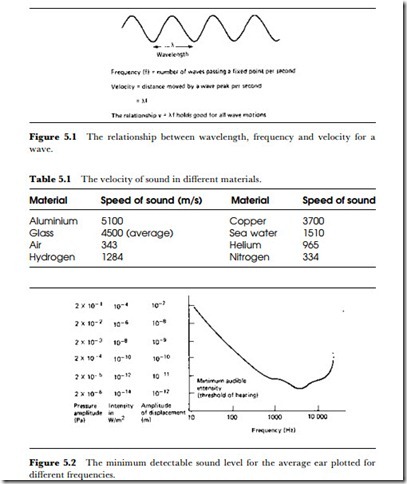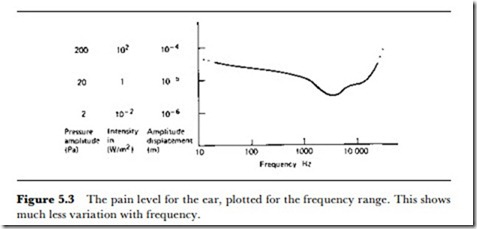Principles
Sound and vibration are connected in the sense that any sound is associated with a mechanical vibration at some stage. Many sounds are caused by the vibration of solids or gases, and the effect of a sound on the hearer is to vibrate the eardrum. The sound wave is the waveform caused by a vibration and which in turn causes an identical vibration to be set up in any material affected by the sound wave. The mechanical vibration need not necessarily cause any sound wave, because a sound wave needs a medium that can be vibrated, so that there is no transmission of sound through a vacuum. Perhaps some day this will penetrate the minds of the makers of ‘space’ films, who always consider sound effects so important.
When sound is transmitted, the wave parameters are veLocity (speed), waveLength and frequency. The frequency and the waveshape are determined by the frequency and waveshape of the vibration that causes the sound wave, but velocity and wavelength are dependent on the medium that carries the sound wave. The relationship between velocity, wavelength and frequency is illustrated in Figure 5.1. The velocity of sound in a given material depends on the density and the elastic constants of the material, and the velocity is highest in dense solids, lowest in gases at high pressure. Table 5.1 shows some examples of values of the speed of sound in common materials.
The perception of sound by the ear is a much more complicated business. Objective measurements of sound waves can make use of the intensity, measured as the number of watts of sound energy per square metre of receiving surface, or of the wave quantities of pressure amplitude or dis- placement amplitude. The ear has a non-linear response, and a sensitivity that varies very markedly with the frequency of the sound. The response of
the ear is at its maximum to sounds in the region of 2 kHz, as the threshold curve of Figure 5.2 illustrates. This curve shows the amount of sound, measured in the three main ways, which is just discernible by the average human ear. The difference in the threshold intensity from the peak sensitivity frequency of about 2 kHz to a bass frequency of 100 Hz is very large, a ratio of about 105 in terms of Wfm2.
There is less variation in the threshold of pain (Figure 5.3), but this curve
also shows the greater sensitivity to sound in the 2 kHz region. The pain threshold has been approached much more frequently in the latter part of the 20th century than in earlier times and frequent bombardment of the ears to energy levels near this threshold results inevitably in deafness. Legislation for health and safety at work is now having some impact on deafness caused by noisy machinery. Nothing seems to put an end to the excessive amplification used in the entertainment industry that is responsible for a much greater incidence of hearing problems. Unfortunately, this is a positive feedback problem, and the volume has to be progressively turned up as the audience becomes more deaf to it. If any factory imposed on its workers the sound levels that are now common in discos, the Health & Safety Executive would close it down.
The frequency range over which sound can be detected by the human ear is limited to the range of about 20 Hz to 20 kHz. In old age, the upper limit is reduced on average by about 1 Hz per day. The lower limit is deter- mined by the sound-filtering effect of tissues in the ear, and avoids the unpleasant effect of the many low-frequency vibrations that exist around us. The transducers that are the subject of this chapter, however, are not necessarily constrained to these frequency limits, and some can be used with infrasound (very low frequencies) or with ultrasound (very high frequencies). Acoustic waves, in fact, can make use of frequencies in the MHz range, well above the upper limit of audible sound. In this region, waves become much more directional and much more subject to filtering effects that can be achieved by shaping the wave path. The topic of surface acoustic filters is based on the effects of surface shape on the transmission of acoustic waves (SAW) along a (solid) surface.
The effect of a sound wave on a material that it strikes is to vibrate the material, and in the course of this vibration every part of the material will be accelerated to and fro. The acceleration is in alternate directions, and there is no bodily displacement of the material, but an electrical output can be obtained from an accelerometer connected to the material. The sensors and transducers for sound to electricity are therefore of the same form as the transducers for acceleration and velocity, and the main differ- ences are the ways in which these sensors and transducers are used. We make use of these devices mainly as transducers, since the aim of a micro- phone is to produce an electrical wave that is a faithful analogue of the sound wave that is striking the microphone. The power conversion, rather than detecting that a wave is present, is the important factor.
• Most microphones depend on a diaphragm as a transducer of sound wave amplitude to mechanical vibration, and it is the vibration of the diaphragm that is then used for sensing or transducing to an electrical form.

